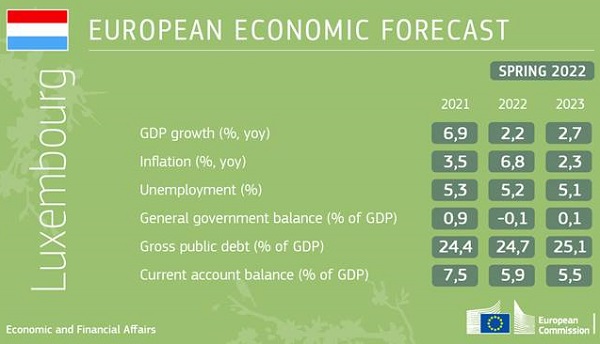 Credit: European Commission
Credit: European Commission
In its "Spring 2022 Economic Forecast", the European Commission has estimated that the Luxembourg economy will continue to grow in 2022 and 2023, albeit at a slower pace than in 2021.
Luxembourg economy
Luxembourg's economy is projected to further grow over the forecast horizon, but at a slower pace of 2.2% and 2.7% in 2022 and 2023 compared to 2021. This is mainly due to Russia's invasion of Ukraine, which is expected to weigh on GDP growth through indirect channels of higher inflation (6.8% in 2022 and 2.3% in 2023) and uncertainty on financial markets.
The general government balance is projected to record a small deficit of 0.1% of GDP in 2022 and a small surplus of 0.1% in 2023 and the debt level is forecast to remain low.
EU GDP is projected to remain in positive territory over the forecast horizon, through the combined effect of post-lockdown re-openings and the strong policy action taken to support growth during the pandemic. Investment is set to benefit from the full deployment of the Recovery and Resilience Facility (RRF) and the implementation of the accompanying reform agenda.
Real GDP growth in both the EU and the euro area is now expected at 2.7% in 2022 and 2.3% in 2023, down from 4.0% and 2.8% (2.7% in the euro area), respectively, in the Winter 2022 interim Forecast. The downgrade for 2022 should be read against the background of the growth momentum gathered by the economy in spring and summer last year, which adds around 2 percentage points to the annual growth rate for this year. Output growth within the year has been reduced from 2.1% to 0.8%.
The main hit to the global and EU economies comes through energy commodity prices. War-induced logistics and supply chain disruptions, as well as rising input costs for a broad array of raw materials, add to the disturbances in global trade caused by the drastic COVID-19 containment measures still applied in parts of China, weighing on production.
Inflation has been picking up momentum since early 2021. From 4.6% year-on-year in the last quarter of 2021, it went up to 6.1% in the first quarter of 2022. Headline inflation in the euro area surged to 7.5% in April 2022, the highest rate in the history of the monetary union. Inflation in the euro area is projected at 6.1% in 2022, before falling to 2.7% in 2023. For 2022 as a whole, this represents a considerable upward revision compared to the Winter 2022 interim Forecast (3.5%). Inflation is expected to peak at 6.9% in the second quarter of this year and decline gradually thereafter. For the EU, inflation is expected to increase from 2.9% in 2021 to 6.8% in 2022 and fall back to 3.2% in 2023. Average core inflation is projected above 3% in 2022 and 2023 in both the EU and the euro area.
Nevertheless, the labour market is entering the new crisis on a strong footing. In 2021, more than 5.2 million jobs were created in the EU economy, which attracted nearly 3.5 million more people into the labour market. In addition, the number of unemployed decreased by nearly 1.8 million people. Unemployment rates at the end of 2021 fell below previous record lows. Labour market conditions are expected to improve further. Employment in the EU is projected to grow by 1.2% this year, though this annual growth rate is spurred by the strong momentum in the second half of last year. People fleeing the war in Ukraine to the EU are expected to enter labour markets only gradually, with tangible effects only becoming visible from next year.
Unemployment rates are forecast to decline further, to 6.7% this year and 6.5% in 2023 in the EU and to 7.3% and 7.0% in 2022 and 2023 respectively in the euro area.
Despite the costs of measures to mitigate the impact of high energy prices and to support people fleeing Ukraine, the aggregate government deficit in the EU is set to decline further in 2022 and 2023 as temporary COVID-19 support measures continue to be withdrawn. From 4.7% of GDP in 2021, the deficit in the EU is forecast to fall to 3.6% of GDP in 2022 and 2.5% in 2023 (3.7% and 2.5% in the euro area).
After decreasing in 2021 to around 90% (97% in the euro area) from the historic peak of almost 92% of GDP in 2020 (almost 100% in the euro area), the aggregate debt-to-GDP ratio of the EU is forecast to decline to around 87% in 2022 and 85% in 2023 (95% and 93% in the euro area, respectively), remaining above the pre-COVID-19 level.
Risks to the forecast for economic activity and inflation are heavily dependent on the evolution of the war and especially on its impact on energy markets. Given the high uncertainty, the baseline forecast is accompanied by a model-based scenario analysis that simulates the impact of higher energy commodity prices, as well as of an outright cut in gas supply from Russia. In the latter, more severe scenario, GDP growth rates would be around 2.5 and 1 percentage points below the forecast baseline in 2022 and 2023, respectively, while inflation would increase by 3 percentage points in 2022 and by more than 1 in 2023, above the baseline projection.
On top of such potential disruptions in energy supply, worse than expected problems in supply chains and further increases in non-energy commodity prices, especially food, could lead to additional downward pressures on growth and upward pressures on prices. Greater than expected second round effects in the face of an imported inflationary shock could compound stagflationary forces. Strong inflationary pressures also come with increased risks to financing conditions. Finally, COVID-19 remains a risk factor.
Beyond these immediate risks, Russia's invasion of Ukraine is leading to an economic decoupling of the EU from Russia, with consequences that are difficult to fully apprehend at this stage, according to the European Commission.








